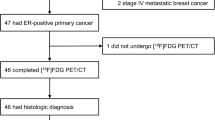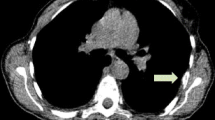Abstract
Purpose
To investigate the correlation between uptake of 16α-[18F]fluoro-17β-oestradiol (FES) and expression of oestrogen receptors as well as other related immunohistochemistry markers, positron emission tomography (PET) was performed in patients with endometrial carcinoma before surgery.
Methods
Nineteen patients with endometrioid adenocarcinoma underwent preoperative PET studies with FES and 2-[18F]fluoro-2-deoxy-D-glucose (FDG). Standardized uptake values (SUVs) for each tracer and the regional FDG to FES SUV ratio were calculated using images after coregistration. PET values were compared with postoperative stage, differentiation grade and immunohistochemical scores including oestrogen receptor subtypes (ERα, ERβ), progesterone receptor B (PR-B), Ki-67 and glucose transporter 1 (GLUT1).
Results
FES uptake showed a significantly positive correlation with expression of ERα. The FDG to FES ratio showed a significantly negative correlation with expression of ERα and PR-B. The FES uptake and FDG to FES ratio did not correlate with expression of ERβ, Ki-67 or GLUT1. FDG uptake was not correlated with any of the immunohistochemical scores. The PR-B score was strongly correlated with the ERα score. Well-differentiated carcinoma (grade 1) showed a significantly higher FES uptake and significantly lower FDG to FES ratio than moderately or poorly differentiated carcinoma (grade 2–3). None of the PET parameters were significantly different between advanced-stage carcinoma (≥ stage IB) and early-stage carcinoma (IA) based on the Féderation International de Gynécologie et d’Obstétrique (FIGO) staging classification. Differentiation grade was the most closely correlated parameter to FES uptake and FDG to FES ratio by multivariate analyses.
Conclusion
FES PET combined with FDG would be useful for non-invasive evaluation of ERα distribution, as well as ERα function, which reflects differentiation grade in endometrial carcinoma.






Similar content being viewed by others
References
Utaaker E, Iversen OE, Skaarland E. The distribution and prognostic implications of steroid receptors in endometrial carcinomas. Gynecol Oncol 1987;28:89–100.
Danforth Jr DN. Hormone receptors in malignancy. Crit Rev Oncol Hematol 1992;12:91–149.
Gustafsson JA. Estrogen receptor β – a new dimension in estrogen mechanism of action. J Endocrinol 1999;163:379–83.
Ogawa S, Inoue S, Watanabe T, Hiroi H, Orimo A, Hosoi T, et al. The complete primary structure of human estrogen receptor beta (hER β) and its heterodimerization with ER α in vivo and in vitro. Biochem Biophys Res Commun 1998;243:122–6.
Jongen V, Briët J, de Jong R, ten Hoor K, Boezen M, van der Zee A, et al. Expression of estrogen receptor-alpha and -beta and progesterone receptor-A and -B in a large cohort of patients with endometrioid endometrial cancer. Gynecol Oncol 2009;112:537–42.
Pertschuk LP, Masood S, Simone J, Feldman JG, Fruchter RG, Axiotis CA, et al. Estrogen receptor immunocytochemistry in endometrial carcinoma: a prognostic marker for survival. Gynecol Oncol 1996;63:28–33.
Creasman WT. Prognostic significance of hormone receptors in endometrial cancer. Cancer 1993;71:1467–70.
Singh M, Zaino RJ, Filiaci VJ, Leslie KK. Relationship of estrogen and progesterone receptors to clinical outcome in metastatic endometrial carcinoma: a Gynecologic Oncology Group Study. Gynecol Oncol 2007;106:325–33.
McGuire AH, Dehdashti F, Siegel BA, Lyss AP, Brodack JW, Mathias CJ, et al. Positron tomographic assessment of 16α-[18F]fluoro-17β-estradiol uptake in metastatic breast carcinoma. J Nucl Med 1991;32:1526–31.
Dehdashti F, Mortimer JE, Siegel BA, Griffeth LK, Bonasera TJ, Fusselman MJ, et al. Positron tomographic assessment of estrogen receptors in breast cancer: comparison with FDG-PET and in vitro receptor assays. J Nucl Med 1995;36:1766–74.
Dehdashti F, Flanagan FL, Mortimer JE, Katzenellenbogen JA, Welch MJ, Siegel BA. Positron emission tomographic assessment of “metabolic flare” to predict response of metastatic breast cancer to antiestrogen therapy. Eur J Nucl Med 1999;26:51–6.
Linden HM, Stekhova SA, Link JM, Gralow JR, Livingston RB, Ellis GK, et al. Quantitative fluoroestradiol positron emission tomography imaging predicts response to endocrine treatment in breast cancer. J Clin Oncol 2006;24:2793–9.
Tsujikawa T, Yoshida Y, Mori T, Kurokawa T, Fujibayashi Y, Kotsuji F, et al. Uterine tumors: pathophysiologic imaging with 16α-[18F]fluoro-17β-estradiol and 18F fluorodeoxyglucose PET–initial experience. Radiology 2008;248:599–605.
Tsujikawa T, Yoshida Y, Kudo T, Kiyono Y, Kurokawa T, Kobayashi M, et al. Functional images reflect aggressiveness of endometrial carcinoma: estrogen receptor expression combined with 18F-FDG PET. J Nucl Med 2009;50:1598–604.
Yoo J, Dence CS, Sharp TL, Katzenellenbogen JA, Welch MJ. Synthesis of an estrogen receptor β-selective radioligand: 5-[18F]fluoro-(2R*,3S*)-2,3-bis(4-hydroxyphehyl)pentanenitrile and comparison of in vivo distribution with 16α-[18F]fluoro-17β-estradiol. J Med Chem 2005;48:6366–78.
Pecorelli S. Revised FIGO staging for carcinoma of the vulva, cervix, and endometrium. Int J Gynaecol Obstet 2009;105:103–4.
Kiesewetter DO, Kilbourn MR, Landvatter SW, Heiman DF, Katzenellenbogen JA, Welch MJ. Preparation of four fluorine-18-labeled estrogens and their selective uptakes in target tissues of immature rats. J Nucl Med 1984;25:1212–21.
Mori T, Kasamatsu S, Mosdzianowski C, Welch MJ, Yonekura Y, Fujibayashi Y. Automatic synthesis of 16α-[18F]fluoro-17β-estradiol using a cassette-type [18F]fluorodeoxyglucose synthesizer. Nucl Med Biol 2006;33:281–6.
Mylonas I, Jeschke U, Shabani N, Kuhn C, Kunze S, Dian D, et al. Steroid receptors ERα, ERβ, PR-A and PR-B are differentially expressed in normal and atrophic human endometrium. Histol Histopathol 2007;22:169–76.
Shabani N, Kuhn C, Kunze S, Schulze S, Mayr D, Dian D, et al. Prognostic significance of oestrogen receptor alpha (ERα) and beta (ERβ), progesterone receptor A (PR-A) and B (PR-B) in endometrial carcinomas. Eur J Cancer 2007;43:2434–44.
Conneely OM, Lydon JP, De Mayo F, O’Malley BW. Reproductive functions of the progesterone receptor. J Soc Gynecol Investig 2000;7:S25–32.
Fukuda K, Mori M, Uchiyama M, Iwai K, Iwasaka T, Sugimori H. Prognostic significance of progesterone receptor immunohistochemistry in endometrial carcinoma. Gynecol Oncol 1998;69:220–5.
Rose PG. Endometrial carcinoma. N Engl J Med 1996;335:640–9.
Kastner P, Krust A, Turcotte B, Stropp U, Tora L, Gronemeyer H, et al. Two distinct estrogen-regulated promoters generate transcripts encoding the two functionally different human progesterone receptor forms A and B. EMBO J 1990;9:1603–14.
Gronemeyer H. Transcription activation by estrogen and progesterone receptors. Annu Rev Genet 1991;25:89–123.
Basu S, Chen W, Tchou J, Mavi A, Cermik T, Czerniecki B, et al. Comparison of triple-negative and estrogen receptor-positive/progesterone receptor-positive/HER2-negative breast carcinoma using quantitative fluorine-18 fluorodeoxyglucose/positron emission tomography imaging parameters: a potentially useful method for disease characterization. Cancer 2008;112:995–1000.
Peterson LM, Mankoff DA, Lawton T, Yagle K, Schubert EK, Stekhova S, et al. Quantitative imaging of estrogen receptor expression in breast cancer with PET and 18F-fluoroestradiol. J Nucl Med 2008;49:367–74.
Mankoff DA, Dehdashti F. Imaging tumor phenotype: 1 plus 1 is more than 2. J Nucl Med 2009;50:1567–9.
Behrooz A, Ismail-Beigi F. Stimulation of glucose transport by hypoxia: signals and mechanisms. News Physiol Sci 1999;14:105–10.
Stoner M, Saville B, Wormke M, Dean D, Burghardt R, Safe S. Hypoxia induces proteasome-dependent degradation of estrogen receptor α in ZR-75 breast cancer cells. Mol Endocrinol 2002;16:2231–42.
Cooper C, Liu GY, Niu YL, Santos S, Murphy LC, Watson PH. Intermittent hypoxia induces proteasome-dependent down-regulation of estrogen receptor α in human breast carcinoma. Clin Cancer Res 2004;10:8720–7.
Yen TC, See LC, Lai CH, Yah-Huei CW, Ng KK, Ma SY, et al. 18F-FDG uptake in squamous cell carcinoma of the cervix is correlated with glucose transporter 1 expression. J Nucl Med 2004;45:22–9.
Helin ML, Helle MJ, Helin HJ, Isola JJ. Proliferative activity and steroid receptors determined by immunohistochemistry in adjacent frozen sections of 102 breast carcinomas. Arch Pathol Lab Med 1989;113:854–7.
Sirvent JJ, Santafé M, Salvadó MT, Alvaro T, Raventós A, Palacios J. Hormonal receptors, cell proliferation fraction (Ki-67) and c-erbB-2 amplification in breast cancer. Relationship between differentiation degree and axillary lymph node metastases. Histol Histopathol 1994;9:563–70.
Gaffney EV, Venz-Williamson TL, Hutchinson G, Biggs PJ, Nelson KM. Relationship of standardized mitotic indices to other prognostic factors in breast cancer. Arch Pathol Lab Med 1996;120:473–7.
Takama F, Kanuma T, Wang D, Kagami I, Mizunuma H. Oestrogen receptor β expression and depth of myometrial invasion in human endometrial cancer. Br J Cancer 2001;84:545–9.
Fujimoto J, Sakaguchi H, Aoki I, Toyoki H, Tamaya T. Clinical implications of the expression of estrogen receptor-α and -β in primary and metastatic lesions of uterine endometrial cancers. Oncology 2002;62:269–77.
Acknowledgments
The authors thank Ms. Yuko Horiuchi, doctors Akiko Shinagawa, M.D. and Yoko Sawamura, M.D. in the Department of Gynecology, Faculty of Medical Sciences, as well as the staff of the Biological Imaging Research Center, University of Fukui, for clinical and technical support. This study was partly funded by the Research and Development Project Aimed at Economic Revitalization (Leading Project) from MEXT Japan, the 21st Century COE Program (Medical Science), and Grants-in-Aid for Scientific Research from the Japan Society for the Promotion of Science (20790887, 21390342) and a Grant-in-Aid for Scientific Research from the Japan Radiological Society.
Conflicts of interest
None.
Author information
Authors and Affiliations
Corresponding author
Rights and permissions
About this article
Cite this article
Tsujikawa, T., Yoshida, Y., Kiyono, Y. et al. Functional oestrogen receptor α imaging in endometrial carcinoma using 16α-[18F]fluoro-17β-oestradiol PET. Eur J Nucl Med Mol Imaging 38, 37–45 (2011). https://doi.org/10.1007/s00259-010-1589-8
Received:
Accepted:
Published:
Issue Date:
DOI: https://doi.org/10.1007/s00259-010-1589-8




